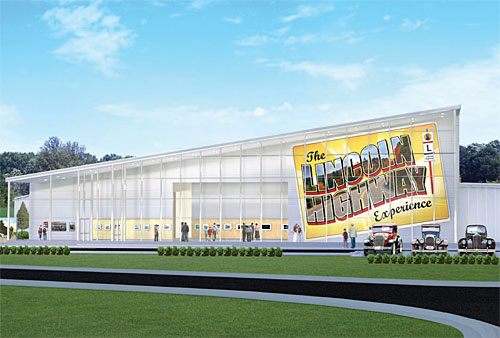Venturi, Scott Brown Designs Decorated Shed for Lincoln Highway

Decorated Shed for Lincoln Highway
Venturi, Scott Brown and Associates recently completed schematic design for the Lincoln Highway Experience, a new museum and visitors center that will celebrate the first road in the U.S. that stretched from coast to coast. The Lincoln Highway was also known as U.S. Route 30. It opened in 1913, and ran from Times Square in New York City to San Francisco’s Lincoln Park.
Photo courtesy Lincoln Highway Heritage Corridor

Decorated Shed for Lincoln Highway
In Pennsylvania, a 200-mile-stretch of the highway is one of the state’s 12 special heritage areas. The VSBA building will sit within 100 feet of the road, within the town of Ligioner.
Image courtesy Lincoln Highway Heritage Corridor

Decorated Shed for Lincoln Highway
Visitors will be lured from the road by a billboard-size postcard marked “The Lincoln Highway Experience” that will hang inside a 1,500-square-foot glass atrium.
Image courtesy Lincoln Highway Heritage Corridor

Decorated Shed for Lincoln Highway
The museum itself will be located in an ordinary 10,000-square-foot metal building right behind the atrium.
Image courtesy Lincoln Highway Heritage Corridor

Decorated Shed for Lincoln Highway
The Maude Group and Kissiloff Planning & Design are responsible for the exhibits and interior spaces.
Image courtesy Lincoln Highway Heritage Corridor

Decorated Shed for Lincoln Highway
Exhibits will include a typical Lincoln Highway main street, vehicles and other artifacts, an auditorium, and a library.
Image courtesy Lincoln Highway Heritage Corridor

Decorated Shed for Lincoln Highway
The museum will contain several full-sized buildings: a gas station and two tourist cabins from the museum’s site, and Serro’s Diner, originally located on the highway in Westmoreland County, Pennsylvania.
Image courtesy Lincoln Highway Heritage Corridor

Decorated Shed for Lincoln Highway
Serro’s Diner is described as the pièce de résistance” of the museum. The 480-square foot prefab was built in Elizabeth, New Jersey in 1938 by the Jerry O’Mahony Company.
Image courtesy Lincoln Highway Heritage Corridor

Decorated Shed for Lincoln Highway
VSBA has completed documents to guide the restoration of the historic structures.
Image courtesy Lincoln Highway Heritage Corridor

Decorated Shed for Lincoln Highway
While the restoration of the buildings is being paid for by a Pennsylvania Department of Transportation grant, fundraising for the Lincoln Highway Experience, which is expected to cost $4.5 million for the building and another $3.5 million for the exhibits, is still in progress.
Image courtesy Lincoln Highway Heritage Corridor Lincoln Highway Heritage Corridor










Architects & Firms
The Lincoln Highway was also known as U.S. Route 30. It opened in 1913, and ran from Times Square in New York City to San Francisco’s Lincoln Park. Americans began their love affair with the automobile on this road, and from its shoulders sprang entirely new kinds of architecture—gas stations, motels, and of course, roadside attractions.
In Pennsylvania, a 200-mile-stretch of the highway is one of the state’s 12 special heritage areas. The VSBA building will sit within 100 feet of the road, in the town of Ligonier. “We hope it will help draw people in to learn about what Lincoln Highway meant to Pennsylvania, and also let them know that it’s part of a larger national story, ” says LHHC’s executive director Olga Herbert.
Visitors will be lured from the road by a billboard-size postcard marked “The Lincoln Highway Experience” that will hang inside a 1,500- square- foot glass atrium. The museum itself will be located in an ordinary 10,000-square-foot metal building right behind it. The Maude Group and Kissiloff Planning & Design are responsible for the exhibits and interior spaces.
The museum will contain several full-sized buildings: a gas station and two tourist cabins from the museum’s site, and Serro’s Diner, originally located on the highway in Westmoreland County, Pennsylvania. VSBA has completed documents to guide the restoration of these structures, which Herbert hopes will be put out to bid in early October. Serro’s is described as the “pièce de résistance” of the museum. The 480-square-foot prefab was built in Elizabeth, New Jersey in 1938 by the Jerry O’Mahony Company. Herbert adds, “People will be able come in and sit at the counter and have a piece of homemade pie and cup of coffee and really experience it.”
Exhibits will include a typical Lincoln Highway main street , vehicles and other artifacts, an auditorium, and a library. The organization’s offices will also be housed in the building. While the restoration of the buildings is being paid for by a Pennsylvania Department of Transportation grant, fundraising for the Lincoln Highway Experience, which is expected to cost $4.5 million for the building and another $3.5 million for the exhibits, is still in progress. It certainly can’t hurt that the building has been designed by the firm whose founding principals, Robert Venturi, FAIA, Denise Scott Brown, FAIA, along with their partner, the late Stephen Izenour, were the authors of the 1977 book that put the decorated shed on the map, Learning from Las Vegas.
Ironically, Herbert was unaware of the firm’s celebration of billboards, ducks, and roadside attractions. “I was checking references,” she says, “and I called a fellow who said he was pleased with their work. He said, ‘Tell me what are you doing? What’s the budget?’ I said, ‘The restoration of a diner. I’m thinking a couple of hundred thousand.’” Herbert was surprised by his response. “You should be honored they bid on it,” he told her. “My budget is $132 million.”
“Then I went online and read about them, I got so excited,” Herbert adds. “I thought, they are a perfect fit for what we’re doing!”
For more information, visit the Lincoln Highway Heritage Corridor web site.










